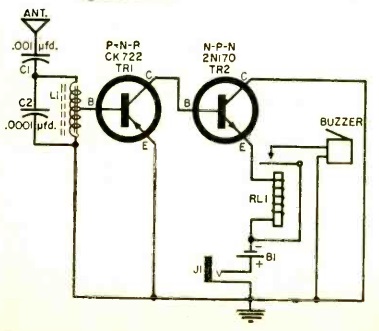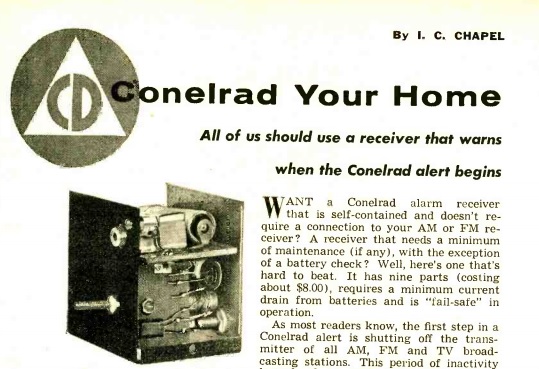An article in the February 1958 issue of Popular Electronics admonishes that “all of us should use a receiver that warns when the Conelrad alert begins,” and the magazine offered a simple circuit, shown here. The concept was about as simple as possible: The little self-contained receiver monitored continuously. If the carrier of the local station disappeared, then a buzzer would sound. Since all stations (other than designated stations on 640 and 1240) were required to leave the air during a CONELRAD alert, this would warn the owner of an impending attack.
It would seem that this particular design would be prone to false alarms. Obviously, it would work only with a 24-hour station. Otherwise, when the station signed off each night, the buzzer would sound until morning. And even most 24-hour stations signed off occasionally for transmitter maintenance. These periods often took place early Monday mornings, so someone relying on this receiver would probably get some rude awakenings if the receiver was left on.
And even though the receiver drew minimal current, it would probably go through the three penlight cells quite quickly.
But since hams were then required to monitor Conelrad, the receiver might have served a useful purpose, even though it probably wouldn’t work too well in continuous service.
 As can be seen from the circuit here, the CK722 served as detector, and the 2N170 was hooked up to a relay, which would turn off the buzzer when the station left the air. The author, I.C. Chapel, notes that the relay is set to trip at 6 mA. At the conclusion of the article, there is an editor’s note stating that this figure “amazed” them, and concluded that the author must be very close to the broadcast station to get these results with his 10-foot antenna. One editor constructed the unit and tried it about 25 miles from New York City, and none of the stations there was strong enough to make the circuit work. With a more sensitive relay and a 150 foot antenna, though, they were able to get it to work with a 250-watt station 10 miles away.
As can be seen from the circuit here, the CK722 served as detector, and the 2N170 was hooked up to a relay, which would turn off the buzzer when the station left the air. The author, I.C. Chapel, notes that the relay is set to trip at 6 mA. At the conclusion of the article, there is an editor’s note stating that this figure “amazed” them, and concluded that the author must be very close to the broadcast station to get these results with his 10-foot antenna. One editor constructed the unit and tried it about 25 miles from New York City, and none of the stations there was strong enough to make the circuit work. With a more sensitive relay and a 150 foot antenna, though, they were able to get it to work with a 250-watt station 10 miles away.
Click Here For Today’s Ripley’s Believe It Or Not Cartoon ![]()

